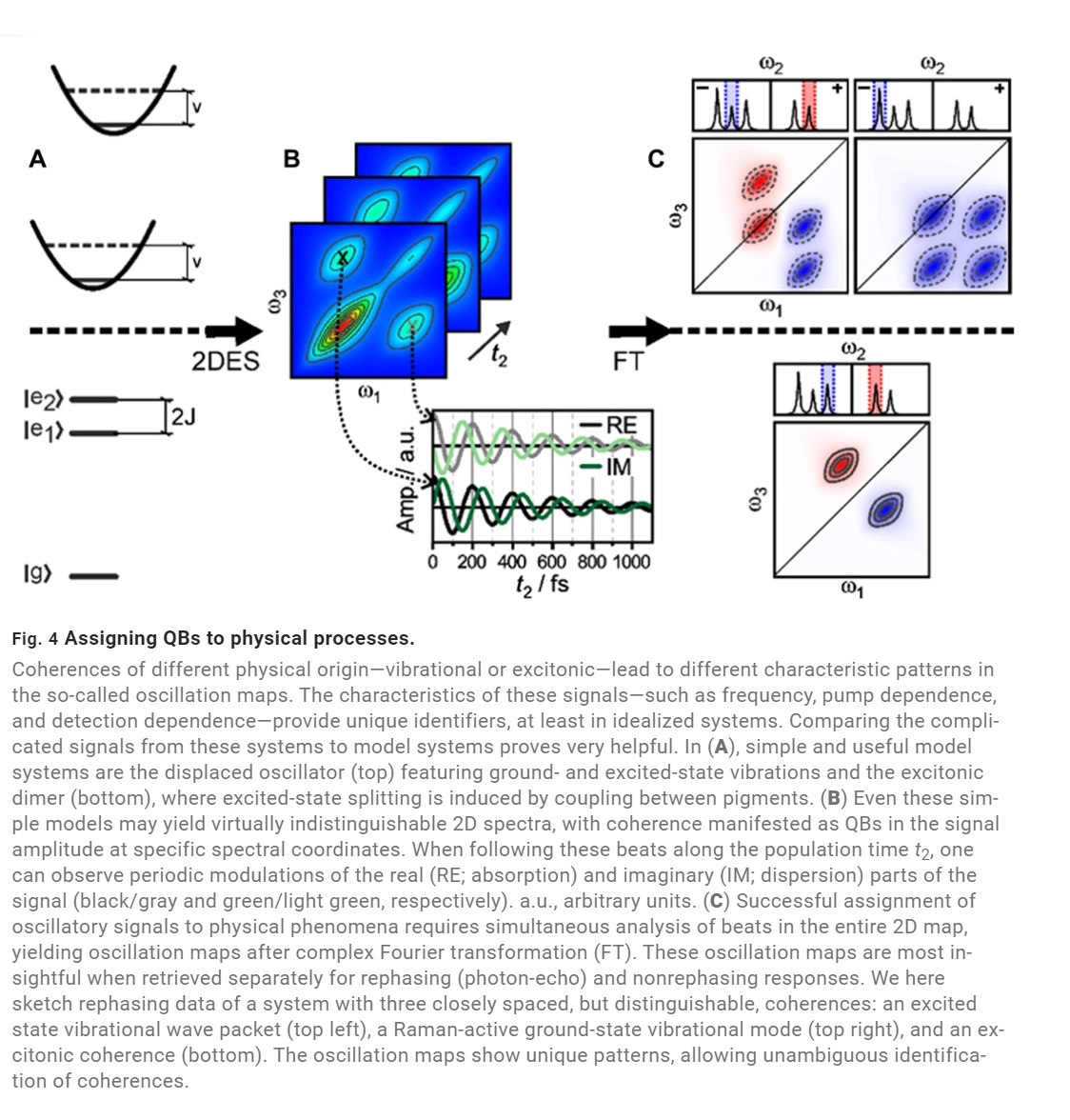INVESTIGATIONS INTO PHOTOSYNTHETIC EXCITONS
We once again stress that the discovery of long-lived oscillations in electronic 2D spectra served as the foundation for the initial argument for the significance of interexciton coherence-or any coherence-in photosynthetic systems. These, with dephasing periods of several hundred femtoseconds or more, were thought to result from linear superpositions of excitonic states. This was interpreted to reflect a link to the kinetics of energy transfer. While the subject of quantum biology as a whole owes much of its development to these experiments, it's crucial to remember that coherence dynamics has a much longer history than this recent surge in interest might imply. In a low-temperature examination of the purple bacterium reaction centre, Vos et al. made the first such observation back in 1991.

In a different early investigation, Chachisvilis et al. (85) examined the central light-harvesting complexes (LH1 and LH2) of purple bacteria and came to the following conclusion: Vibrations were the root cause of the observed QBs. By observing oscillations in the pump-probe anisotropy of the FMO complex at 19 K in 1997, Savikhin et al. (86) made the first observation of interexciton coherences contributing to the signals of PPCs. The rapid dephasing of 200 fs was in good agreement with naive predictions for the dephasing of interexciton coherence in a biological system at low temperatures and suggested that this coherence's dephasing in biological conditions should be too rapid to significantly contribute to the function of light-harvesting.
This proposal implied not only that decoherence occurred much more slowly than a plausible physical model at the time would have permitted, but also that the extremely successful paradigm of energy transfer in light-harvesting systems, based on incoherent transport of energy between partially-localized exciton states, would need to be changed. It was hypothesised that long-lived interexciton coherence was common in natural photosynthesis as a result of similar spectral signatures-small-amplitude oscillations-reported in other animals. In other words, nature had figured out a way to use quantum coherences to control biological processes.
Even though these investigations have sparked a great deal of interest in coherent events, the experimental foundation for the excitonic interpretation was compromised by a partial understanding of the 2D spectra. These studies, in particular, heavily depended on kinetic traces taken from just a small number of sections of the 2D spectra, usually just one or two, due to practical signal-to-noise considerations. Coherence signals are frequently complex and challenging to consistently identify, as we demonstrate in Fig. 4 , necessitating a more comprehensive interpretation of the complete 2D dataset. Coherence signals are highly entangled in the presence of vibronic mixing of electronic and vibrational states, which appears to be the case in many photosynthetic complexes, making an oscillation map analysis (Fig. 4) essential.

We have reviewed the quantum elements of harvesting photosynthetic light in conclusion. Basic reasoning has shown that the quantumness of the processes and the coherences detected in femtosecond spectroscopy investigations are not equivalent. Even the most basic question of whether sunlight may trigger nonstationary coherences in photosynthetic systems still has to be fully answered . The associated couplings of the system and its interaction with the bath will control the dynamics regardless of the state preparation. Additionally, assertions that these coherences persist in femtosecond tests have been rigorously reassessed.
In particular, a thorough examination of the FMO complex, a model system for quantum biology, demonstrates categorically that long-lived interexciton coherence is absent in this system on pertinent time scales, both at cryogenic and physiological temperatures. It has instead become evident that the long-lasting oscillating signals are mostly generated by vibrational modes on the electronic ground state. For the accurate identification of coherence signals, more sophisticated data processing and theoretical treatments utilising realistic parametrization of the bath are required. This need is shown by the lengthy debate surrounding the first assignment of these spectral signatures, which has been going on for a decade in the community.
The main benefit is the advancement of theoretical and experimental techniques, which has helped us comprehend the system-bath interactions that cause decoherence and dissipation in biological systems better. Natural selection does not design the bath to prevent decoherence from guiding functional processes; such a strategy is probably certainly not robust. Nature particularly leverages dissipation together with the engineering of site energies and excitonic coupling to direct energy transmission, as opposed to trying to avoid it. On other levels, the influence of thermodynamic variables on biological processes is well understood. Here, we see that this assumption holds true even for the fastest-acting energy transfer procedures involved in photosynthesis. The orientation is imposed using the fundamental physics of thermalization. This straightforward idea, which nature has successfully applied across all relevant temporal and spatial scales, is truly a wonder of biology.
